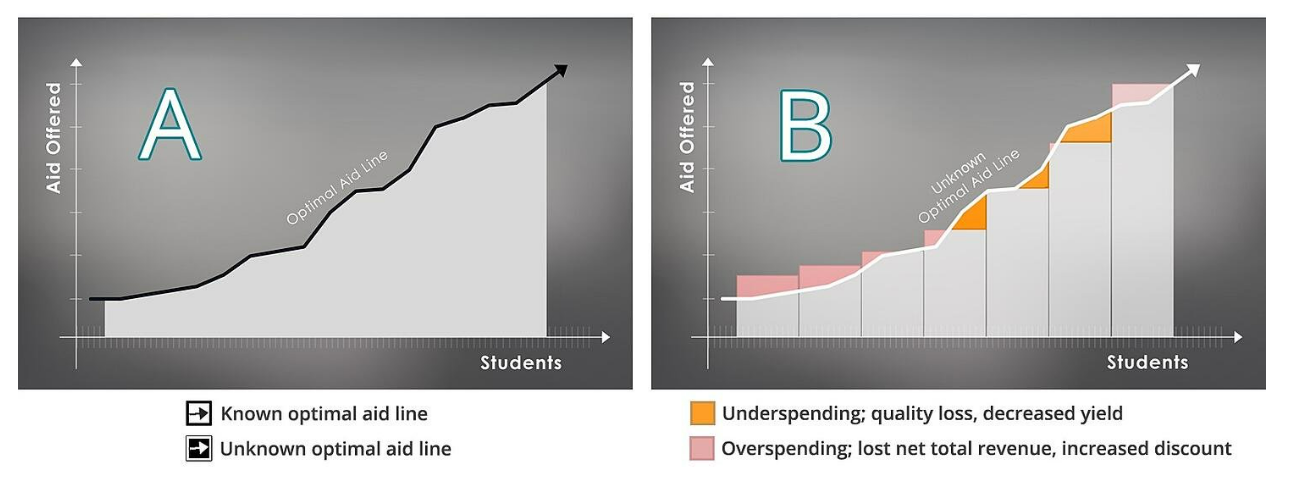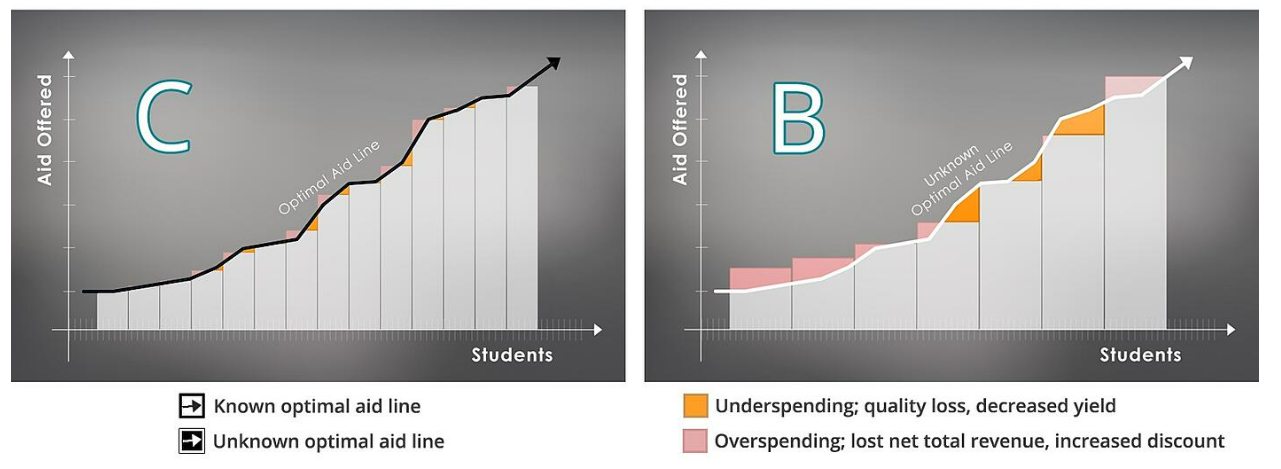 Aug 23, 2022
Persona
Aug 23, 2022
Persona
You may have heard that one of the industry’s most trusted and reputable enrollment management firms, is now part of the Carnegie family! With this partnership comes the capacity to support clients in critical areas like financial aid modeling, recruitment modeling, student success modeling, and more. It also means we’ll be able to share our expertise in these areas with you here on the Carnegie blog!
Given this subject matter is new to our blog, we’ve asked our experts to break down terms and concepts related to financial aid optimization. Read on to build your lexicon and learn about our individualized approach to financial aid strategy. Whether you’re new to enrollment management or financial aid or you’re tenured in the field, we think there’s something here for everyone.
Building your financial aid lexicon
What is modeling?
Modeling is the use of data science to predict key decision points like a student’s likelihood to apply, enroll, and retain.
What is financial aid modeling?
In financial aid modeling, you leverage the probability of those events (apply, enroll, and retain) to optimize the use of limited resources ($) and achieve enrollment goals.
What is financial aid optimization?
Financial aid optimization is the use of predictive models to determine each student’s likelihood of enrolling at the institution and how institutional grant and scholarship awards affect that probability. Understanding the relationship between net cost and yield ensures that institutions can focus their limited aid resources on critical enrollment goals like headcount, net tuition revenue, and cohort composition.
Example: Knowing how likely a student is to enroll can help you decide what financial aid package will increase the chance of their enrollment and if you can afford that spend. This process is used to motivate students your institution believes are the right fit while also balancing the cost to educate the student body as well as the fixed operating costs of the institution.
Aid strategy types and the goals they fulfill
What are the most common financial aid strategies in higher education?
- Grid: A grid strategy is a two-factor (GPA/standardized test scores and need) awarding strategy that’s usually delivered in a 5×5 grid, thus the name. This strategy is offered by many partners in our industry. The foundation of this strategy is this: lower-achieving individuals receive less money, higher-achieving students receive more money, lower-need students receive less money, and higher-need students receive more money. So the high-academic-achieving, high-need student usually receives the most institutional aid. The grid is a one-size-fits-all standardized product, with 25 buckets (5×5). Typically, this product is handed over to you as the client and you then administer aid based on the grid system. One positive of this system is that it’s predictable, and as a result, award estimates are easily calculated and can be offered up in early recruitment conversations.
- Individualized: An individualized financial aid strategy is a predictive model based on your past enrollment data, in addition to inputs of need and academic achievement, to optimize your awarding on a per-student basis. This sets individualized strategy apart from other strategies: Each individual student will have a precise aid strategy calculated for them based on a multitude of factors. This ideal model is first built to maximize each student’s probabilistic contribution to net revenue, then can be adjusted to accomplish your enrollment goals (like program headcount, academic profile, and yield %) while still maximizing revenue. This is the most precise method for allocating funds because there are multiple factors considered and there’s a strategy for each individual student.
A quick aside for the marketing communications parallel: The grid system is like sending out email communications by school (business, arts and sciences, etc.), while the individual strategy is like sending out email communications segmented by persona types and also using dynamic content to populate their program interest.
- Matrix: A financial aid matrix strategy uses a full and unique individualized model to optimize the aid offering on a per-student basis, but then it’s backed into a custom grid for your team’s execution. This awarding matrix is more granular than a 5×5 grid, maximizing spending efficiency because there are more buckets, while being predictable enough to be calculated for early recruitment conversations.
What enrollment goals can financial aid strategy be used to optimize?
The requirement for every enrollment office is to recruit next year’s class, and in doing so, balance and meet the institution’s goals of headcount, net tuition revenue, quality and composition, yield, and retention. These are the goals financial aid strategies are used to achieve.
- Financial aid strategy can help you better understand the statistically significant factors that predict enrollment decisions at your institution and use that knowledge to influence enrollment outcomes during the admissions stage of the cycle.
- It can project and target a discount rate and revenue goal.
- It can ensure you confidently meet tight capacity restrictions and enrollment guidelines for capped programs and demographic goals.
- A good financial strategy will determine how many admits are necessary, both overall and in segments of interest (by program, state residency, etc.) to reach your strategic goals.
As enrollment managers, we’re often asked to achieve all of these goals…at the same time. Just as often those goals are in conflict—like enrolling a bigger class and spending less to do it, for example. This is where the analysis of your specific institutional data and the expertise of your partner comes into play. Additionally, working with a partner who stays involved and helps monitor and optimize your strategy can be the difference marker in tough strategic situations. In the example above, a more precise model might find that you have been overspending and repurpose those funds into more impactful buckets to achieve a larger class and a lower spend. The beauty of our preferred strategy—individualized aid—is that you can get really granular and accomplish goals that are seemingly in conflict.
Why we recommend individualized awarding
Take a look at this model of a class of students, where Image A is the individualized awarding and Image B represents a popular (but not with us!) grid-based model.

In all cases, some students will come to your institution with little aid, while others will require larger packages to enroll.
In Image A, each student receives their optimized award amount. The line follows no particular pattern because each student’s award is based on their individual characteristics and is created to maximize each student’s probabilistic contribution to net revenue.
Image B represents a grid-based awarding system. While it will provide packages that are ideal for a few, it will miss the mark by a considerable amount for many. Students who are similar, but not the same, are packaged into groups, and students in each group are awarded the same amount. Additionally, an individualized awarding equation was not calculated in the first place, so the grid doesn’t hug the ideal line because it’s not known. Some grids over-award large groups, needlessly increasing discount rate and reducing net total revenue (red), while others under-award many, sacrificing yield and perhaps quality (orange).
Are grid systems bad?
No—with a foundation of individualized awarding, a granular matrix system can be very useful for the right institution. This strategy is built by first calculating the most effective and cost-efficient award for each student, then constructing a grid based on that unique formula, seen in Image C. You can see the results and comparison to the grid strategy in Image B.

And for some institutions, the basic grid system might yet be the right choice. Like all things in enrollment management—it depends.
How do you know which aid strategy your partner is using?
Ask your partner these questions:
- Am I receiving individualized aid amounts based on a unique formula or an award for each student that is a sum of their qualifying awards (i.e., bucket six award amount + in-state award)?
- Is the product you’re offering an award automation product or a strategy that produces an award for each student in my applicant pool?
- Can my individualized awarding or awarding grid discern the statistically significant differences of two very similar students?
We hope you found this information helpful! Check back to learn more about recruitment modeling and student success modeling in future blogs.
Want to learn more about Financial Aid Optimization? Start a conversation with a strategist today!
